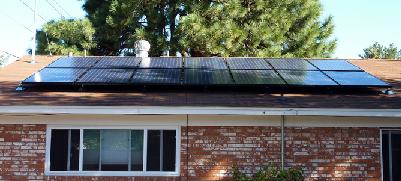When deciding to install a solar photovoltaic system, the positioning of the solar panels is vital. It is pretty obvious that the solar panels should be orientated such that they face the sun at the time of day when the sun is highest in the sky; but a secondary important consideration is shading.

If even a small section of a photovoltaic panel is shaded – for example by the branch of a tree – there is a very significant drop in power output from the panel. This is because a PV solar panel is made up of a string of individual solar cells connected in series with one another. The current output from the whole panel is limited to that passing through the weakest link cell. If one cell (out of for example 36 in a panel) is completely shaded, the power output from the panel will fall to zero. If one cell is 50% shaded, then the power output from the whole panel will fall by 50% – a very significant drop for such a small area of shading.
Shade Damage to Solar Panels
In addition to a loss of power output, shade can have much more serious effects on photovoltaic solar panels – hot spot damage to cells in which a shaded cell or cells overheat and potentially burn out.
Solution – Bypass Diodes
The obvious solution is to locate the solar array somewhere that shade is not an issue during the peak sunlight hours, but this is not always possible – particularly on boats. Bypass diodes can be connected between panels in a system, and also between groups of cells in a panel so that the only power loss is from the shaded portion.
When a panel is partially shaded, the current from the un-shaded part of the panel passes through a diode which bypasses the shaded group(s) of cells. While some power is lost as heat in the diode due to the voltage drop, the overall power generation of the partially shaded panel is better than it would be without the diodes, and the diodes also protect the panel from damage.
If making your own solar panels there are cost implications in adding bypass diodes – both in time and money, but low drop Schottky diodes are relatively inexpensive, and a few extra metres of wire will not break the bank. Therefore, since a solar panel can operate maintenance free for decades, it is well worth adding bypass diodes when building the panel, or paying a little extra for a retail solar panel featuring bypass diode protection.